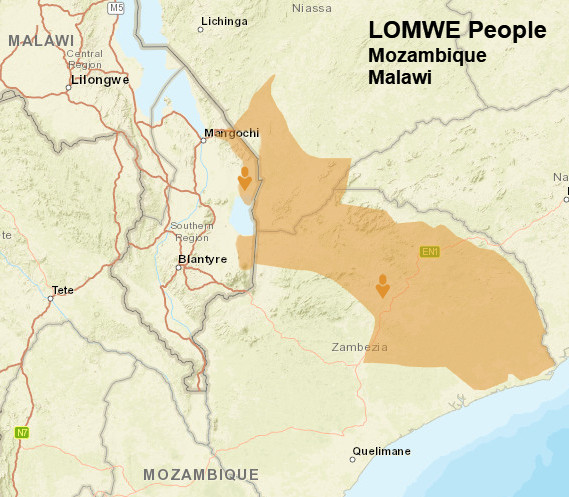

The Lomwe people are one of the largest tribes residing in Mozambique and Malawi. In Mozambique their language is spoken by many in central Mozambique. In Malawi they are second largest tribe after the Chewa Tribe. They speak the Malawi Lomwe language. They are located primarily in the southeast section of Malawi with the largest concentration being in Phalombe district. Others live in Mulanje, Thyolo, Chiradzulu, Zomba, and Liwonde. Smaller numbers are scattered throughout the southern region of Malawi. In Mozambique, the Lomwe are found almost entirely in the Zambezia Province. |
 |
The Lomwe are originally from what is now Mozambique to the east of Malawi. In 1996, a source indicated that the majority lived in Malawi. However, current sources now indicate that the population in Mozambique is about double that in Malawi. The total popualtion reported in current sources sources is also considerably less that the population reported in 1996.
In 1996 the figure reported by certain sources within Malawi was 1.8 million in Malawi and 1.35 millon in Mozambique. Today, a larger population of Lomwe live in Mozambique, about 1.3 million compared to about 700,000 million currently living in Malawi. However, we are aware that population figures are often unreliable in these countries. The Bible Society of South Africa says: "Nearly 2 million people in Mozambique are Lomwe-speaking."
The Ethnologue reported in 1996 that the total number of Lomwe speakers (then considered one language in both countries) was 2,850,000. The Ethnologue reported new research in 2005, yielding a population of 1.3 million speakers of Lomwe (ngl) in Mozambique and only 250,000 speakers of Lomwe, Malawi (lon). Other sources report about 700,000 Lomwe in Malawi.
This figure of 700,000 may be the total ethnic figure in Malawi, since the Ethnologue reports that Chewa (Nyanja) is a mother tongue among many of the ethnic Lomwe in Malawi. The whole tribe seems to be shifting into the Chewa language stream, as are other small tribes in Malawi.
The migration of large numbers of Lomwe to Malawi had taken place before the arrival of missionaries, white traders, and colonialists in the latter part of the nineteenth century. There was also a large influx of Lomwe into Malawi in the 1930's because of tribal wars in Mozambique. A more recent contributor to the Lomwe migration to Malawi was Mozambique's long civil war. Perhaps many have now returned since the stablization of Mozambique.
The Lomwe are Bantu people as are most of the people of southeastern Africa. The Lomwe are part of a larger cluster called the Makhuwa-Lomwe Group. Together the tribes of this cluster make up almost 40% of the population of Mozambique. In the past Lomwe women made distinctive scarification marks on their cheeks, but this custom is dying out.
The Lomwe are a rural people with only 5-10% living in urban areas. They are primarily subsistence farmers. Many of them love to hunt though wild game is scarce.
The Lomwe language is written using the Roman alphabet. Lomwe people in Mozambique speak Elomwe as their heart language. In Malawi the situation is somewhat different. Although the Lomwe are continuing to keep many of their traditions, the Lomwe language is being used less and less with only the elderly still continuing to use it as their first language. In Malawi, most of the Lomwe speak Chichewa which was made one of the two national languages of Malawi in 1968.
Until recently linguists thought the sp;eech of all the Lomwe groups was one language. More recent research has shown tha Lomwe in Malawi is not mutually intelligible with Lomwe in Mozambique. The 2005 Ethnologue has reported them as two different languages. They call the Mozambique speech Lomwe and assign it the language code ngl. The speech of Malawi is called Lomwe, Malawi and has a code of lon.
Lomwe speakers are reported generally to have a low literacty rate. Exact literacy figures are vague.
Mozambique's muddy political history has not greatly influenced the rural dwelling Lomwe people, except to continue scattering the peoples over the area and into Malawi. Neither the Portuguese culture nor Marxist teaching were seriously embraced by these people. In Malawi, the three main parties are somewhat aligned along regional lines. The Lomwe identify mainly with the ruling party which is the predominant party in the Southern Region.
Lomwe customs are centered around work and play. The men build the houses, the barriers to protect the gardens, and the grain bins to store the maize. They also like to make grass or reed mats.
In the past the men have been skilled hunters, but there is little game remaining to be hunted. The major tasks of the women are cooking and caring for the children. Also they enjoy making clay pots. The young girls start helping their mothers at an early age often carrying their younger siblings on their backs when they can barely do so. The Lomwe enjoy working together as evidenced by friends and neighbors working together cultivating one another's fields.
The religious leaning of the Lomwe vary greatly with the degree of penetration of Christianity. The Baptist Union in Mozambique has had a strong influence in areas surrounding its churches. However in general, the Lomwe are animists who still worship ancestral spirits. Though most Lomwe would consider themselves Christians, the traditions of the ancestors greatly influence their daily lives.
Recent analysis has led to a classification of religion for the Malawi Lomwe as Traditional Religion. In Mozambique, it is reported that Traditional Religion, Christianity and Islam are found among the Lomwe.
Sources: